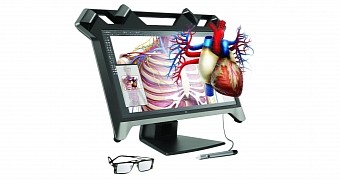Holographic technology may be beyond man at the moment, but that doesn't mean that we can't simulate the functionality. Having already figured out gesture recognition, it is now being combined with “normal” displays to produce things like the HP Zvr monitor.
Now that the Consumer Electronics Show is ready to kick off, companies attending it in Las Vegas, Nevada are already officially releasing their latest creations.
HP has a whole bunch of different things on show, including a fairly extensive line of new displays, particularly monitors.
We've seen a display with a resolution of 5K, which could probably have carried HP through CES 2015 all on its own. Hewlett-Packard is a big name, however, so it couldn't have really afforded to go easy.
The HP Zvr Virtual Reality Display
The HP Zvr is powered by zSpace technology, which allows users to interact with on-screen items and manipulate them as though they were physical objects. It's the first virtual reality display.
Well, that's how HP described it. The reality isn't nearly as grand as the PR suggests, since it's not a case of an eyeset that immerses you in another world.
Instead, it is a 3D monitor which you can manipulate with a stylus in order to, say, poke at a heart. Hand gestures should also allow you to “grab” a ball or stick.
The frame of the Zvr is quite strange, due to having to combine together all relevant motion detection and tracking technologies.
The only thing missing is a processing platform, but this is ultimately a monitor, not an all-in-one PC. All the computing is done by a computer, in this case an HP Z Workstation. Dual-link DVI and DisplayPort connectors maintain the link between the two.
Finally, the screen size is of 23.6 inches (diagonal) and the resolution is of 1920 x 1080 pixels for each of the two sets of images forming the 3D feed (yes, glasses are needed).
Availability and pricing
The HP Zvr monitor, complete with software designed by zSpace, will probably cost a few thousand dollars, since zSpace values its technology at around $4,000 / €3,362 per product.
A lot, to be sure, but since this is a highly specialized piece of technology, it's not likely to be needed by consumers anyway. And companies specializing in graphic design and 3D virtualization will probably be able to spare the money for one or two of these things, eventually.

 14 DAY TRIAL //
14 DAY TRIAL // 